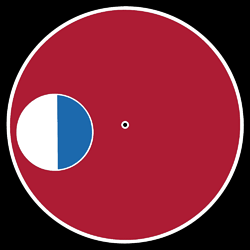Hey everyone,
I’m making a watch that has a moon phase that rotates around it’s origin (as usual) but I also want to have the “Facer Moon Phase” in the creator to orbit around the origin as the “Frame”.
I have a photo of the red frame rotate according to the known moon phase rotation, but I need help on the X and Y expression for the blue moon phase circle orbiting the origin.
Below are some photos for understanding where red=frame and blue=facer moon phase.
At third Quarter example:
For those who help I say an enourmous Thank You. This forum has helped me multiple times in the past.
1 Like
As far as I’ve seen, there is no tag for the moon phase, so there is nothing to base the rotation on, unless you calculate the moon phase yourself. There is some discussion about that in this thread: [SOLVED] How To Tag Moon Phase Today Rotation
Yes, I use the following expression for the red frame:
(2*(4+((round((((((((floor(365.25*((#Dy#-1)+4716))+(2-floor((#Dy#-1)/100)+floor(floor((#Dy#-1)/100)/4))-1096.5+#DD#+(#Dk#/24+#Dm#/1440))-2451550.25972)/29.530588853)-floor(((floor(365.25*((#Dy#-1)+4716))+(2-floor((#Dy#-1)/100)+floor(floor((#Dy#-1)/100)/4))-1096.5+#DD#+(#Dk#/24+#Dm#/1440))-2451550.25972)/29.530588853))*29.530588853))*1000)/10)/100)*6.095374558767523)))
All I need now is the rotational code for the moon phase to orbit alongside the frame.
1 Like
Assuming that gives you an angle between 0 and 360, you know angle and you know the radius, so using sohcahtoa (google that, facer has sin cos and tan functions) would get you the x and y (with some fiddling to convert it to a top-left origin)
This works for me:
x = (160 + (120 * cos(([your formula] - 90) * 0.0174532925)))
y = (160 + (120 * sin(([your formula] - 90) * 0.0174532925)))
The first 160 is the center of the watch (assuming it is 320 by 320).
The 120 is the radius of your circle
The -90 is to start your angle at the top (normally it starts at the right)
The * 0.01745… is to convert degrees to radians, for the cos/sin functions
1 Like
I have to give an enormous thank you. It worked exactly as I wanted it. 
Just a small update: as I’m new to Facer, I did not know all the functions it had, but it would be cleaner to use the rad function instead of the “* 0.017…” to convert degrees to radians:
x = (160 + (120 * cos(rad([your formula] - 90))))
y = (160 + (120 * sin(rad([your formula] - 90))))
Thank you. I must say that this formula can be used for many things, not only my situation. Once again, thank you.


